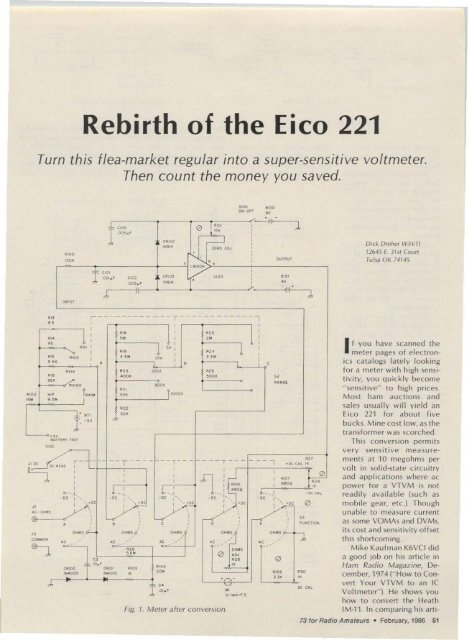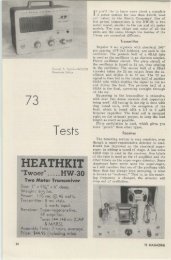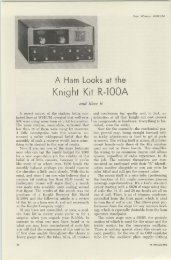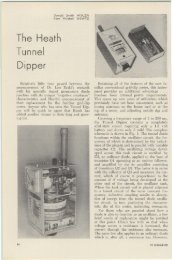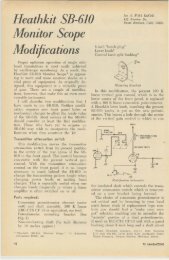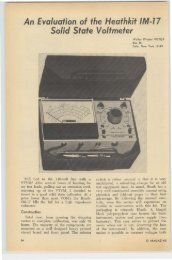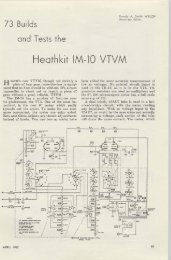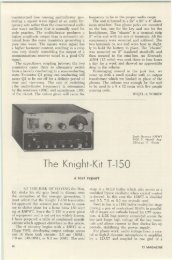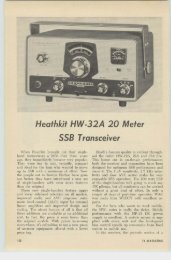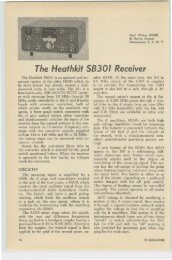Rebirth of the Eico 221 - Nostalgic Kits Central
Rebirth of the Eico 221 - Nostalgic Kits Central
Rebirth of the Eico 221 - Nostalgic Kits Central
You also want an ePaper? Increase the reach of your titles
YUMPU automatically turns print PDFs into web optimized ePapers that Google loves.
<strong>Rebirth</strong> <strong>of</strong> <strong>the</strong> <strong>Eico</strong> <strong>221</strong><br />
Turn this flea-market regular into a super-sensitive voltmeter.<br />
Then count <strong>the</strong> mone y you saved.<br />
~ ' oo<br />
, ~O .<br />
C ~' 0 2<br />
,"...,.<br />
e<br />
~t O '<br />
".<br />
Dick Dreher \\ '5VT/<br />
126-J5 E. Jhl Court<br />
rulS
PRoal<br />
TIP<br />
SM< lLOEO t.f.Sl<br />
I<br />
r-------------,<br />
, '<br />
1002 F 20 ..[
8100,8101<br />
Cl00, C102<br />
Cl01<br />
CR100, CR101<br />
Al00<br />
R1 01<br />
R102<br />
R103<br />
A,04<br />
A,OS<br />
R106, 107<br />
8 ' 00<br />
5 101<br />
"'00<br />
Parts Li st<br />
s.c-vort transistor battery with connectors<br />
(battery holders optional)<br />
O .OO5-~ F. 5O-volt mica<br />
O .OO l·~F.50-volt mi ca<br />
1N4oo5 or equivalent 6oo·piv,1·Amp<br />
diode<br />
lOOk, 114 W, 10%<br />
POI. 15k, 112 Watt, penei-mc unt type<br />
15 meg, 114 Watt. 10%<br />
1k, 1/4 Walt, 10% (can use old Rl0 or<br />
R11)<br />
20 meg, 1/4 Watt, 10% or !2) 10 meg,<br />
114 Walt, 10% in series<br />
3.3k, 114 Watt, 10%<br />
680 Ohms, 1/4 Walt, 10%<br />
toggle swi tch, OPST<br />
toggle switch, SPOT<br />
IC, National Semiconductor lM,J1 0H<br />
volt age follower<br />
non sw itch and is relocated<br />
on <strong>the</strong> chassis. Use insula ted<br />
hookup w ire for all wiring.<br />
l ead dress is not cr itical, but<br />
capacitors Cl 00. Cl 0l , and<br />
Cl 02 should be wired close<br />
to Ul00 Rl 0b and Rl07 can<br />
be m ounted o n Function<br />
sw itch 53. Break <strong>the</strong> w iring<br />
to R27 and R29 and insert<br />
<strong>the</strong>m in series. Rl0S is inserted<br />
from R30 to 53, deck<br />
E. Break wiring to R30 and<br />
put in series. Be sure to<br />
gro und <strong>the</strong> w ire which went<br />
to pi n 3 o n th e V2 (65N7)<br />
socket and decks D and Eon<br />
<strong>the</strong> Function sw itch.<br />
Theory <strong>of</strong> Operation<br />
C apac it o rs Cl OD and<br />
C102 bypass <strong>the</strong> battery<br />
p ower su pply. Diode s<br />
CR102 and CR103 prevent<br />
an overvoltage condit io n if<br />
you are probing a large voltage<br />
while <strong>the</strong> meter is<br />
switched to a low-voltage<br />
range. They limit vo lt age on<br />
Ul00, pin 3 to ± 9 .0 voltsde.<br />
Resistor Rl00 limits current<br />
into CR102 and CR103 and<br />
forms part <strong>of</strong> <strong>the</strong> protective<br />
circu it ry . Ca pac itor ( 101<br />
keeps any ac out <strong>of</strong> Ul00's<br />
input. Its val ue is not critical<br />
except increa sing its value<br />
will increase <strong>the</strong> measuring<br />
ti me. Potentiometer R101 is<br />
<strong>the</strong> new Zero Adjust pot.<br />
D iodes CR100 and CR101<br />
replace <strong>the</strong> original 6H6 diode<br />
circuit. They shou ld be<br />
m ount switch 5101 (1.5-V<br />
Batterv Test sw itch) This<br />
switch does two things-it<br />
f ills a vacant hole. bu t more<br />
important. it allows you to<br />
te st <strong>the</strong> ohm meter 1.S-volt<br />
battery. Break <strong>the</strong> w ire from<br />
th e Functio n switch to Jl (dc<br />
jack) and wire in this sw itch.<br />
Rl02, <strong>the</strong> l S-megohm resistor,<br />
can be mounted on<br />
Range sw itch 52 .<br />
M ount sw itch 5100 in <strong>the</strong><br />
hole where <strong>the</strong> original O n<br />
Off sw itc h (51) w as located.<br />
Batteries B100 and Bl 01<br />
may be mounted in special<br />
clips avai lable for <strong>the</strong>m or<br />
m ounted to <strong>the</strong> chassis with<br />
cable ties o r strapping tape.<br />
Use connectors that m at e<br />
<strong>the</strong>m or make your own<br />
from d iscarded 9 0-volt bat <br />
teries. Batteries need replacing<br />
periodically, so so ldering<br />
<strong>the</strong>m is not advisable.<br />
Ul00 can be so ldered into<br />
one <strong>of</strong> <strong>the</strong> existing tube<br />
socke ts or pu sh out one o f<br />
<strong>the</strong> transform er grommets<br />
and in sert a round nylon<br />
8-pin IC socket in <strong>the</strong> hole<br />
and wire to <strong>the</strong> socket.<br />
Al l remaining parts m ay<br />
be w ired to <strong>the</strong> two remaining<br />
sockets or mount to<br />
so me 3-lug solder st rips<br />
mounted o n <strong>the</strong> chassis A<br />
perforated Vectorboard "<br />
could al so be u sed . This part<br />
<strong>of</strong> <strong>the</strong> conversion is m ostly<br />
left up to <strong>the</strong> hobbyi st's ingem<br />
ntv. ( 4 was on th e Funcat<br />
least 600-piv , 1 -A m p and chassis and a senous<br />
types. CR100 clips <strong>the</strong> negative<br />
...hock could result. A sug<br />
half <strong>of</strong> <strong>the</strong> cycle to gested method is to use a<br />
g rou nd a fte r cou plin g 6.3-V -a c tran sformer and<br />
through capacitor C3. CR101 . calibrate <strong>the</strong> meter on <strong>the</strong><br />
Rl04, and R103 "steer" <strong>the</strong> 10-V -ac ran ge, com pa ring<br />
positive ha lf <strong>of</strong> <strong>the</strong> cycle to <strong>the</strong> reading with a known<br />
<strong>the</strong> Function switch and good meter.<br />
Range sw itch circuit as dc A lways turn this meter <strong>of</strong>f<br />
input does C4 bypasses any when not using it. as th e<br />
stray ac to ground.<br />
LM-310H draw s about 4 rnA<br />
and will consume <strong>the</strong> ba t-<br />
Calibration<br />
teries in a period <strong>of</strong> time. An<br />
With unit power <strong>of</strong>f and LE D Power On ind icat or<br />
<strong>the</strong> 5101 l .5-V Battery Test would consume 20 rnA from<br />
sw itch ...et to De Read, ad- <strong>the</strong> power supply, so it w as<br />
just <strong>the</strong> mechanical zero not part <strong>of</strong> this co nvers ion<br />
sc rew o n <strong>the</strong> meter until <strong>the</strong> Ano<strong>the</strong>r usefu l appliesneedle<br />
points to zero. Turn non in ham radio for this<br />
<strong>the</strong> 51 00 meter p owe r convers ion is to u se an rf<br />
sw itch on and ad just <strong>the</strong> probe into <strong>the</strong> ac input and<br />
Zero Adju st control (R101 ) measure relative power o utuntil<br />
little or no change oc- pu t and a nte n na f iel d<br />
cu rs when <strong>the</strong> Func t ion stren gth. A short piece <strong>of</strong><br />
switch goe s from +dc to wire or a clip lead on th e<br />
- dc w ith no probe input. end o f an rf probe will pick<br />
Probe a known dc vo ltage up enough rf energy to give<br />
and adjust <strong>the</strong> De Cal con- a good reading. <strong>Eico</strong> had a<br />
tro] for <strong>the</strong> correct m eter model PRF -25 probe availread<br />
ing. Po sition <strong>the</strong> 1.5-V ab le for this V1VM, or a sim -<br />
Battery Test sw itch to read ple probe may be rnade with<br />
<strong>the</strong> ohm meter battery on a 1N48 diode. a 002-jJF,<br />
<strong>the</strong> S-V sca le. You should 600·V capacitor. and a<br />
read about 1.5 volts on a 20-megohm, 1!2-W att resisnew<br />
battery. Position it back tor in a shielded tube or ento<br />
De Read . Next. switch th e closure. See Fig. 2.<br />
Func t ion switch t o <strong>the</strong> lf vou strll need a rrnlltam-<br />
Ohms position and set <strong>the</strong> meter, <strong>the</strong> basic movement<br />
Ohms Adjust control on <strong>the</strong> here is 0 -1 rnA dc full scale.<br />
front panel so <strong>the</strong> meter Mount a DPDT switch on<br />
reads infinity resistance (on <strong>the</strong> front panel and wire <strong>the</strong><br />
left side <strong>of</strong> scale) w ith <strong>the</strong> re- meter term inals to <strong>the</strong> comsist<br />
ance probe open -err - m an cont acts. Wire two<br />
cu ited (not sho rted to <strong>the</strong> banana jack s to <strong>the</strong> normalground<br />
probe). To uching lv-clos ed co ntacts and con<strong>the</strong>se<br />
probes toge<strong>the</strong>r will nect <strong>the</strong> two o riginal meter<br />
bring <strong>the</strong> needle to read wires to <strong>the</strong> normally-open<br />
zero Ohm... on <strong>the</strong> right side contact s (see Fig. 3). The<br />
<strong>of</strong> <strong>the</strong> meter scale. b anana jacks could be<br />
Never leave <strong>the</strong> meter in mounted o n <strong>the</strong> back <strong>of</strong> <strong>the</strong><br />
<strong>the</strong> Ohms position or 5101 in cab ine t. O f course. <strong>the</strong> main<br />
<strong>the</strong> 1.S-V Battery Test posi- on-<strong>of</strong>f sw itc h sta ys <strong>of</strong>f to use<br />
tion as <strong>the</strong> latter d isables <strong>the</strong> t he l-mA function. By expermeter<br />
from reading dc and imenting w ith resistor shunts<br />
<strong>the</strong> first is normal proce- ac ross <strong>the</strong> banana jacks, this<br />
dure. The battery cou ld l-mA ran ge ca n be extended<br />
d rain over a few months. Fi- to seve ral Amps. Start with<br />
na lly, put <strong>the</strong> Fu nc tion about 90 Ohms and go as<br />
sw itch in <strong>the</strong> Ac position low as 0 .1 Ohms and comand<br />
adjust <strong>the</strong> Ac Cal pot p a re t he reading with<br />
until a known ac vo ltage ano<strong>the</strong>r milliammeter in<br />
reads correctly on <strong>the</strong> m e- series with th is meter beter.<br />
Caut io n: Do not u se <strong>the</strong> tween a de power source<br />
ac l ine to calibrate this me- and a load With <strong>the</strong> proper<br />
ter as one side <strong>of</strong> <strong>the</strong> l ine shunt. this meter sho uld<br />
w ill alw ays be on <strong>the</strong> panel track <strong>the</strong> known meter. .<br />
73 for Radio Amateurs . February, 1986 53


